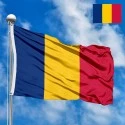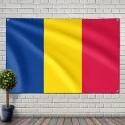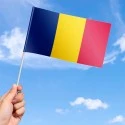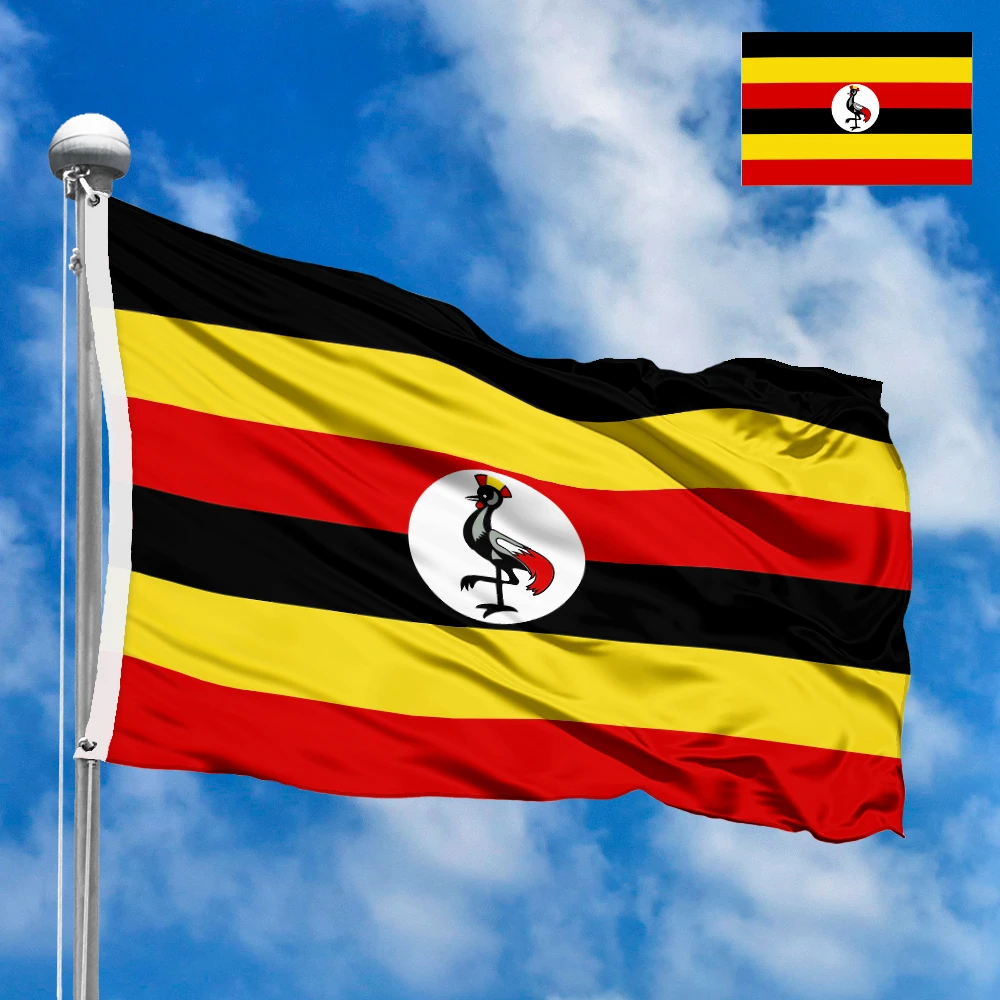The national flag of Chad is a beacon of its identity, a vibrant symbol reflecting the nation's diverse geography, its rich aspirations, and the historical journey towards self-determination. Adopted on November 6, 1959, while Chad was still an autonomous republic within the French Community, the flag's design remained unchanged upon achieving full independence on August 11, 1960. This enduring emblem encapsulates the spirit of a landlocked country at the heart of Africa, a nation of contrasts from arid deserts to fertile savannas, united under a common banner. This comprehensive exploration delves into the flag's simple yet profound design, the deep meanings behind its vertical stripes, its historical evolution, its geographical context, and its significant resonance among the people of Chad.
Design and Dimensions
The flag of Chad features a straightforward and striking design, a vertical tricolor that is both elegant and symbolic.
-
Overall Design: The flag consists of three equal vertical stripes of blue (hoist side), yellow (middle), and red (fly side). This simple, clean layout allows the colors themselves to carry the weight of national symbolism without additional emblems or charges.
-
Dimensions: The official proportions for the flag are typically 2:3 (height to width). This ratio ensures visual balance and clarity, making the flag recognizable whether it's flying high or depicted in official contexts.
-
Color Arrangement:
-
Blue Stripe (Hoist Side): Positioned closest to the flagpole, the blue stripe is usually a deep, rich shade, often described as dark blue or indigo. It primarily symbolizes the sky, representing hope and optimism. It also represents the waters of Lake Chad, a vital lifeline in the Sahel region, and the rivers that nourish the more fertile southern parts of the country. Furthermore, it can be seen to embody the southern, more agricultural regions of Chad, characterized by their savanna landscapes and water bodies.
-
Yellow Stripe (Middle): Occupying the central position, the yellow stripe is a bright and warm color. It symbolizes the sun, a dominant feature in Chad's predominantly arid climate. Crucially, it represents the desert – particularly the vast Sahara Desert that covers the northern half of Chad – and the wealth and prosperity the nation aspires to achieve through its natural resources and human endeavors. It is the color of sand, a stark reminder of the immense desert landscapes.
-
Red Stripe (Fly Side): The outermost stripe is a vibrant red. This color carries a profound meaning, representing progress, unity, and the sacrifices made for the nation. It specifically symbolizes the blood shed by the martyrs and patriots who fought for Chad's independence and who continue to work for its future. It is a powerful reminder of the nation's struggle and its determination to move forward as a unified entity.
Symbolism of the Colors
Each color on the Chadian flag is meticulously chosen to encapsulate core aspects of the nation's identity, aspirations, and geographical realities.
-
Blue: This color is multi-faceted in its symbolism. It evokes the boundless sky above Chad, suggesting hope, freedom, and the vast expanse of the future. Importantly, it also signifies the water resources crucial to a largely arid country. This includes the life-giving Lake Chad, one of Africa's largest wetlands, which sustains millions across the region, and the rivers like the Chari and Logone that flow through the greener southern regions. In a broader sense, it highlights the importance of agriculture and the natural environment in the country's south.
-
Yellow: The yellow stripe represents the radiant sun, which blesses Chad with abundant light and warmth but also signifies the harsh realities of the desert. The vast Sahara Desert dominates Chad's northern landscape, making yellow an apt representation of its golden sands and the unique challenges and beauty of this immense natural feature. Beyond geography, yellow also stands for the wealth and potential of the Chadian people and their natural resources, including mineral deposits.
-
Red: The red stripe is a powerful testament to the courage, unity, and sacrifice of the Chadian people. It honors the blood shed by those who fought for independence and those who have contributed to the nation's development. It symbolizes the continuous progress Chad aims for, its commitment to national cohesion, and the enduring spirit of its citizens. Red is a unifying color, binding together the diverse elements of the nation in a common destiny.
History of Creation and Adoption
The creation of Chad's national flag is rooted in its transition from a French colony to an independent state, a process that saw the adoption of national symbols even before full sovereignty was achieved.
-
Colonial Era (Pre-1959): Before 1959, Chad was a territory within French Equatorial Africa. The French Tricolour (blue, white, red vertical stripes) was the official flag flown throughout the colony. As Chad moved towards greater autonomy, the need for a distinct national symbol became apparent.
-
Influence and Design Choice: The design of the Chadian flag is often noted for its resemblance to the flags of Romania and Moldova (though Moldova includes a coat of arms). While not directly copied, the choice of a vertical tricolor format was a common one among former French colonies, reflecting the influence of the French flag. The specific colors chosen for Chad were a deliberate blend of Pan-African colors (red, yellow, green, though Chad uses blue instead of green) and the colors of the French Tricolour (blue, red), albeit in a different arrangement. The aim was to create a unique emblem that distinguished Chad from its neighbors while incorporating elements of its historical and geographical identity. The combination of blue (for sky and water), yellow (for sun and desert), and red (for sacrifice and unity) was specifically chosen to represent Chad's unique features.
-
Adoption (November 6, 1959): The current flag was officially adopted by Law No. 1 in 1959, on November 6, 1959, while Chad was still an autonomous republic within the French Community. This was a crucial step in asserting its emerging national identity.
-
Continuity Upon Independence (August 11, 1960): When Chad gained full independence from France on August 11, 1960, the newly formed government chose to retain the flag adopted in 1959. This continuity underscored the stability of its national symbols and the enduring relevance of its chosen design, solidifying its place as a permanent emblem of the sovereign nation. The flag has remained unchanged since, a testament to its foundational significance.
Country, Region, and Acceptance
Chad is a large, landlocked country situated in Central Africa. It is strategically located, bordering Libya to the north, Sudan to the east, the Central African Republic to the south, Cameroon and Nigeria to the southwest, and Niger to the west. Its vast territory spans multiple climatic zones, from the Sahara Desert in the north, through the semi-arid Sahelian belt, to the more fertile savanna regions in the south.
The flag of Chad is the undisputed official national symbol of the Republic of Chad. It is universally accepted by the government, all state institutions, the armed forces, and the vast majority of its citizens, both within the country and among the Chadian diaspora. It is prominently displayed at government buildings, schools, embassies, military installations, and during national celebrations, serving as a unifying emblem of the nation's sovereignty, resilience, and collective identity. Its widespread use and unwavering recognition underscore its importance as a symbol of unity for a diverse population.
Significance for the Inhabitants
For the people of Chad, the national flag holds profound and multi-layered significance, embodying their history, their geographical diversity, and their hopes for the future:
-
Symbol of Hard-Won Independence: The red stripe, in particular, serves as a constant and solemn reminder of the sacrifices made and the blood shed by the generations of Chadians who fought for liberation from colonial rule. It instills a deep sense of gratitude and patriotism, honoring those who paved the way for the nation's sovereignty.
-
National Unity Amidst Diversity: Chad is a country of immense geographical and ethnic diversity, encompassing desert dwellers, pastoralists, and agricultural communities. The flag, through its simple yet powerful design, acts as a potent symbol of national unity. It reminds citizens that despite their regional or ethnic differences, they are all part of one unified Chadian nation, striving for collective progress and peace.
-
Connection to Land and Environment: The blue and yellow stripes vividly represent the nation's fundamental connection to its natural environment. The blue symbolizes the life-giving waters and fertile lands of the south, while the yellow signifies the vast, sun-drenched desert landscapes of the north. This visual representation fosters a shared understanding and appreciation of Chad's unique and varied geography, from Lake Chad to the Sahara.
-
Aspiration for Progress and Prosperity: The colors collectively embody the nation's aspirations for progress, development, and a prosperous future. The blue of hope, the yellow of wealth (potential), and the red of progress and unity are not just colors but promises and goals that guide the nation's journey.
-
Source of National Pride: For Chadians, the flag is a potent source of national pride and identity. Displaying or honoring the flag is an act of patriotism, celebrating their unique history, their resilience in the face of challenges, and their status as a sovereign nation. It is a unifying emblem that transcends local differences and fosters a collective sense of belonging.
-
Resilience and Endurance: The fact that the flag's design has remained unchanged since its adoption, even through periods of political instability, speaks to its enduring power and the stability of its core national ideals. It represents the resilience of the Chadian spirit and its ability to weather storms while maintaining its fundamental identity.
Interesting Facts
-
Landlocked Giant: Chad is one of the largest landlocked countries in Africa, covering a vast area of over 1.28 million square kilometers (496,000 square miles). This geographical feature heavily influences its trade and development.
-
Lake Chad's Significance: Lake Chad is one of Africa's largest and historically most important freshwater bodies, though its size has dramatically shrunk over the past few decades due to climate change, desertification, and increased water usage. It is a crucial source of water for millions of people in Chad, Nigeria, Niger, and Cameroon.
-
"Dead Heart of Africa": Chad is sometimes referred to as the "Dead Heart of Africa" due to its remote, largely arid, and landlocked nature, particularly its vast desert regions.
-
Cultural and Linguistic Diversity: Chad is incredibly diverse, home to over 200 distinct ethnic groups and languages. The official languages are Arabic and French, reflecting its historical connections to both the Arab world (via the Sahara trade routes) and its colonial past.
-
Oil Production: While traditionally an agrarian economy (cotton, livestock), Chad has become an oil-producing nation since the early 2000s, with pipelines connecting its oil fields to the Atlantic coast via Cameroon. This has brought new economic opportunities but also challenges related to governance and wealth distribution.
-
Geographical Extremes: The country boasts extreme geographical diversity, from the Sahara Desert and the Tibesti Mountains in the north (including Emi Koussi, the highest peak in the Sahara) to the Sahelian belt in the center and the relatively fertile savanna in the south.
-
Ancient Civilizations: The Chad Basin region has been inhabited for thousands of years and was home to ancient empires and kingdoms, such as the Kanem-Bornu Empire, which significantly influenced the history of the Sahel.
-
Challenges: Despite its natural resources, Chad faces significant development challenges, including poverty, food insecurity, limited infrastructure, and the impacts of climate change, particularly concerning Lake Chad.
In the demonstration images, full-size flags are shown with proportions of 2:3, and hand-held flags with proportions of 1:2.







 Waving flag
Waving flag
 Sizes:
Sizes:
 Round flag
Round flag
 Sizes:
Sizes:
 Rectangular flag 2:3
Rectangular flag 2:3
 Sizes:
Sizes: